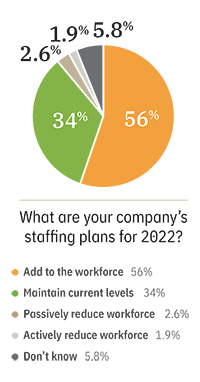Food and beverage processors are more or less optimistic heading into 2022, according to the results of Food Processing’s 21st annual Manufacturing Survey.
Almost half (47%) said they were “somewhat optimistic” about their companies’ prospects in 2022, and another 25% said they were “very optimistic.” Only 8% admitted to any pessimism.
The great majority (81%) of the respondents say they anticipate that their plants will increase production next year, with 20% saying that the increase will be 20% or more. Only 2% said they expected a decrease.
Download Your Copy
The charts shown in this article have barely scratched the surface of the data we collected. Visit our Equipment Resource Library to download the full report.
In addition, a plurality of 47% said they expect their companies to open or add lines or entire plants. Only 5% said they anticipate any mergers or closings of lines or plants, and 38% said they expect things to stay the same.
Capital spending was a sign of the general optimism. Almost half (48%) said they anticipated an increase in their companies’ capital spending budget. Among these, 18% said they think the budget will go up more than 10%, and another 17% said it will go up from 5% to 10%.
In a list of options for capital spending, the No. 1 choice was process equipment, followed by control systems and packaging equipment. Some of the more interesting responses among “Other” include: “To expand the production to other regions, for instance Asia and Africa”; “Investing in machine learning and artificial intelligence for better automation and blockchain development”; “converting lines to control sesame as an allergen”; and one that said simply, “Each plant has a project in the works.”
Another indication of optimism comes from staffing plans. A majority of 56% said they think their companies will add to the workforce in 2022, while 34% said they expect to maintain staffing levels. Only 5% think their workforces will be reduced.
Split on the pandemic
The pandemic, naturally, was a major topic of concern – and divisiveness. A plurality of 40% said their companies require neither vaccinations nor testing, and have no plans to do so. Proof of vaccination or weekly COVID tests – the standard that the Biden administration is trying to impose – is being followed, or soon will be, by 34%; another 25% said their companies require, or soon will, vaccinations with few or no exceptions.
Comments on this question were fairly wide-ranging. “Currently, COVID 19 vaccination has been made compulsory for all employees,” said one. “Cannot afford even one case of pandemic infection,” said another. Another said “Will abide with government regulation.” But this was balanced out by comments like “Mandate illegal in our state & will be struck down by supreme court” and “My body my choice...FREEDOM.”
The split mirrors that of society as a whole, with some businesses beginning to add “no vaccine required” as an enticement to job ads. In some cases, it’s due to the convictions of the businesses’ owners; in others, it’s a desperate ploy to attract workers in a tight labor market.
One concern that we didn’t offer as an option came up frequently in the comments: supply chain. As one commenter put it: “Supply chain is an issue for us. Cost control was much higher than expected, as we are paying 5-6 times the expected price for ingredients.”
Cost control means dealing with inflation, which will require a higher level of cost management. “With the high price inflation numbers, the majority of the costs are being passed along to consumers and the major players will continue to manage pricing across their supply chain to establish a new supply and demand curve,” says Tyler Higgins, retail practice lead and managing director at consulting firm AArete.
Safety and automation
Food safety was the No. 1 concern. Asked to choose from a list of practices to enhance food safety, the most popular option, at 71%, was employee training. More or improved sanitary equipment was the second choice at 46%, followed by “HACCP plan” at 37%.
Comments revealed other paths to follow. Two people mentioned certification from the SQF (Safe Quality Food) Institute. One referred to “improved cleaning chemicals for CIP” (clean in place). And a couple said simply, referring to the options offered in the survey, “These are all ongoing practices we do every year.”
An ongoing challenge for the industry is digital technology and automation, which we ask about every year. The most popular two response were the same as last year: “replacing paper records with electronic records,” chosen by 61% of respondents, and “replacing analog devices with digital sensors and meters,” at 47%. (Multiple responses were permitted.)
Several commenters mentioned remote access to equipment, by its manufacturers and others, but there was some caution: “Due to security issues, we grant only required remote access to machine controls,” one said.
A big part of the challenge for automation is establishing a workforce that can handle it reliably. Our survey presented a list of options, with multiple responses permitted; the most popular one, at 49%, was “expanding in-house technical training.” No. 2, at 44%, was “recruiting maintenance technicians”; the third choice, at 39%, was “adding in-house engineering capabilities.”
Some of the comments offered some additional perspective. "We are simply seeking [workers who can handle automation] in the workplace. We have added programs to work with new employees out of college to address needs,” said one. “Still TBD as we determine the exact equipment upgrades to be installed,” said another, while another said simply, “Maintenance technicians are hard to come by.”
Our survey also included the opportunity for miscellaneous comments, about whatever is on the respondents’ minds. Some of the more interesting include:
- “Getting more raw produce from a limited number of agricultural fields.”
- “Constant changing rules and regulations at all levels of government need to be addressed more.”
- “Certain cumbersome quality functions could be outsourced, but there are not parties performing those functions, e.g., annual vendor qualification requirements.
While there are databases, there is not a competent source to whom this function could be outsourced in its entirety. A gap in the market place for someone to fill.”
Who Answered the Survey
Our 2022 Manufacturing Survey, conducted online in late 2021, garnered 156 responses from food and beverage industry professionals. In terms of what is manufactured, the most common categories were further-processed foods, at 13%; baked goods, at 11%, and meat/poultry/seafood at 9%. In number of employees, the most frequent range was 101 to 500, at 37%, followed by 11 to 50 at 21%.





